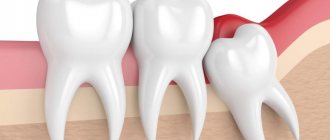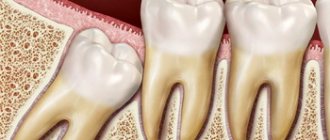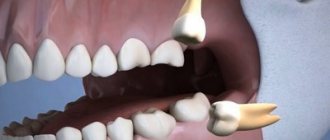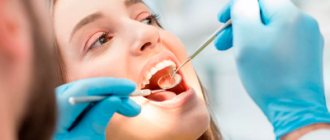For most people, the growth of wisdom teeth is accompanied not only by gum cutting and discomfort, but also by quite severe pain that makes it difficult to eat, concentrate on any task, and even sleep.
If the wisdom tooth grows and does not cause significant discomfort, no medical action may be taken. As a rule, the discomfort goes away after 1-2 weeks, but in order to avoid the manifestation of other problems, it is worth undergoing an examination at a dental clinic. However, if the gums from the wisdom tooth become inflamed, the local and general temperature rises, and specific aching pain is felt, immediately contact your dentist, he will conduct an examination and take the necessary measures to eliminate the problem.
Symptoms of wisdom tooth growth
During the period when a wisdom tooth comes in, a number of specific symptoms can be observed, by which it can be determined that the discomfort comes specifically from the eights:
- Discomfortable sensations in the tooth area, in some cases – gum thickening;
- Feeling of swelling in the gums;
- Increased local temperature, painful swelling;
- In the molar area, soft tissues (gums) become inflamed;
- Difficulty opening the mouth and swallowing. When opened wide, a sharp, aching pain is felt;
- There is a desire to chew any hard food or objects. After such chewing, the pain increases significantly;
- General increase in body temperature, general malaise and headaches.
Depending on the nature of growth, pain in wisdom teeth and specific symptoms can vary significantly. Regardless of how long a wisdom tooth grows - one or two weeks, it will cause certain sensations, and in case of complex or pathological growth - acute pain with inflammation of the gums.
An increase in general body temperature and swelling of the cheek indicates a severe course, as well as the possible development of pericoronitis - a complex disease of the oral cavity with a number of consequences.
The tooth hurts when you press on it: after depulpation (nerve removal)
The pulp is nerve fibers and vessels that provide sensitivity and nutrition to the tooth. After their removal, the tooth is considered dead, and it may seem that this is the solution to any problem, because a dead tooth is unlikely to hurt. This is wrong. A pulpless tooth can be disturbing for several reasons:
- if the dentist, while cleaning the canals, punctured the root;
- when the thin end of the endoscopic instrument breaks off and remains inside the canal;
- in case the dental canals have not been completely cleaned and an infection remains in them.
In the first two cases, the pain is quite sharp: the pulpless tooth hurts not only when pressed, but even when touched lightly. If the dentist cleans the canals poorly, pain appears after some time. In any case, a tooth without a nerve that causes discomfort is a reason for a repeat visit to the dental office.
The main causes of pain
Painful symptoms from wisdom teeth are caused by the anatomical features of the upper and lower jaw, which are already fully formed in a person at the age of 17-25.
As the figure eight begins to grow, it puts pressure on neighboring teeth, bone and soft tissue. The growth process can last for months and even years, so pain manifestations are temporary, periodically fading and exacerbating.
The pain of tooth 8 can be provoked not only by its growth or anatomically incorrect position, but also by the presence of various pathologies, for example, caries, pulpitis, periodontitis or a wide range of infectious diseases. Note! The lack of timely professional help can provoke a worsening of the situation, which will result in the need to remove the diseased tooth and treat complications.
The treated tooth hurts when pressed after canal filling
Working with roots requires precision and accuracy from the doctor. If he incorrectly assessed the depth of the canals, then the following complications cannot be excluded:
- a tooth without a nerve hurts when pressed if the filling material extends beyond the apex of the root, gets into the gum and puts pressure on it;
- when the channels, on the contrary, are not completely filled, inflammation may begin in the voids over time. If a lot of time has passed after visiting the doctor, and the tooth aches and hurts, then the problem is the unsatisfactory filling of the canals.
How to relieve pain if a wisdom tooth grows and your gums hurt.
The growth of wisdom teeth is not painless for every person, so most people need to know what to do in case of inflammation of the gums around the wisdom tooth and acute aching pain.
If there is inflammation, pain, or if the cheek is swollen near the wisdom tooth, you should contact your dentist, he will conduct an examination and take the necessary measures to eliminate symptomatic manifestations.
If the pain begins in the evening or it is not possible to quickly contact a specialized specialist, doctors recommend several ways to reduce pain:
- Rinse the growth with calendula tincture after eating - this will reduce the intensity of the inflammatory process and also reduce pain;
- Rinse your mouth with a solution of baking soda in water, at the rate of 1 teaspoon of soda per 1 glass of water (200 grams) - soda calms inflammation and also reduces pain;
- To rinse the mouth, you can use decoctions of chamomile, oak bark, chicory root, as well as sage tincture and propolis;
- Anti-inflammatory, painkillers and antibacterial drugs - use according to the instructions. They help reduce pain, reduce swelling, and also eliminate the negative bacterial influence at the site of tooth eruption.
In case of acute unbearable pain, as well as the absence of the above remedies, you can use cold water to reduce pain: take a glass of cool water, put a small amount in your mouth and hold it in the area where the wisdom tooth is erupting - this can quickly reduce the level of pain. However, this method has one negative feature - the pain intensifies almost immediately after stopping holding cool water at the site of gum inflammation, for example, near the hood of a wisdom tooth.
Tooth hurts when pressed after filling
Slight pain after the doctor has given a filling to the patient is normal: during the sanitization of cavities affected by caries, the tissues receive microtrauma. The condition is easily treated with analgesics and goes away on its own in 2-3 days. But if a filled tooth hurts when pressed hard enough, then the problem is one of five reasons:
- high filling - the occlusion is disrupted, the tooth experiences excessive pressure and becomes painful;
- the dental pulp was burned when the filling was treated with a photopolymer lamp;
- a gap has appeared between the filling and the enamel, into which bacteria and food particles have entered, causing inflammation;
- the cavities affected by caries were not drilled out thoroughly enough, and it reappeared;
- I developed an allergy to the filling.
If the tooth under the filling hurts when pressed, this means that you need to make an appointment with the doctor again and have it filled again.
Where can I get dental care in Orenburg?
If your gums hurt where your wisdom teeth are, you can get qualified dental care in two places: public and private dental clinics. During the appointment, the dentist must:
- Conduct a preliminary examination of the oral cavity, determine the exact cause of the development of painful symptoms;
- If necessary, refer the patient for an x-ray - this procedure is often necessary in the presence of impacted wisdom teeth (completely or partially covered by gum), as well as in the case of surgical removal;
- Take the necessary measures to reduce or eliminate pain and swelling, as well as prevent further aggravation of the situation;
- If necessary, refer to a dental surgeon to remove third molars;
- Provide recommendations for further dental and oral care.
Do your gums hurt and you have symptoms of wisdom tooth growth? Seek qualified help from specialized specialists!
Treatment methods
Experts practice removal of wisdom teeth in case of carious lesions or in cases where extremely problematic eruption is observed for people of any age. Pain and inflammation indicate a serious problem. If it is not resolved in a timely manner, complications cannot be avoided.
Easy removal
The doctor decides what to do in each specific situation based on the research results obtained. This can be either a simple removal or a rather complex multi-stage operation.
Before the procedure, the specialist must make sure that the patient is not allergic to the medications that will be used during the procedures. First, the soft tissue around the tooth and the nerves are numbed. After the anesthesia has taken effect, the tooth is removed using forceps. The duration of the entire procedure does not exceed 10 minutes.
Difficult removal
If the crown of a tooth is destroyed, it has large branched roots, and also if the “eight” has not erupted at all, and the entire jaw is involved in the inflammatory process, complex removal is practiced. During the intervention, the dental surgeon makes one or more incisions, removes the tooth, washes the wound surface, and then applies sutures.
It is also worth mentioning the procedure for excision of the hood. If it is the wisdom tooth that hurts at the time of eruption due to inflammatory processes of the mucous membrane, the doctor removes fragments of “excess” tissue. There may be situations when the wisdom tooth is not removed, but only soft tissue correction is performed. This is true if the tooth itself does not hurt and is located correctly in the socket.
Where can the pain go?
Quite often, the process of growth of eights is accompanied by uncharacteristic symptoms. Moreover, some of them are due to the growth of the molar itself, and the other part indicates the development of complications. Let's take a closer look - can a wisdom tooth give into...?
- Head
- in case of complicated teething it can. - Eye
– with complicated eruption of the upper molars and the development of an abscess, it can. - Tongue
- a symptom indicates the presence of purulent inflammation of the soft tissues closer to the tongue. - Ear
– indicates the development of inflammation, pulpitis or dental cyst. - Throat
- most likely we are talking about pulpitis. - Jaw
- a symptom characteristic of complicated teething and inflammation. - The neck
is unlikely, unless we are talking about the spread of infection and inflammation of the lymph nodes. - Temple
– Clicking and pain in the temple may be present due to tension in the temporomandibular joint, which occurs from constant pain. - The teeth are nearby
- of course, because the figure eight can put pressure on them.
Important! The above list is a serious signal to contact a dentist. Don't delay your visit to the clinic!
Indications for removal
Wisdom teeth removal is carried out if the following indications are present:
- Horizontal growth of the molar (promotes displacement of teeth in a row);
- the figure eight occupies an anatomically incorrect position and harms neighboring units;
- incomplete eruption (impacted tooth);
- pulpitis, periodontitis;
- impossibility or inappropriateness of endodontic treatment.
If the wisdom tooth on top hurts, it is easier to remove it than the lower third molar. The lower eights are distinguished by large, developed, often tangled roots, and the mandibular bone itself has a more dense structure. The complexity of surgical extraction depends on:
- Wisdom tooth positions;
- the position of neighboring units that complicate extraction;
- degree of eruption;
- the number of roots, their confusion.
An orthopantomogram gives the doctor the necessary information about the position of the figure eight and its condition.
What you can do yourself
If the tooth hurts severely, and for some reason it is impossible to get an appointment with a doctor today, you should rinse with a saline or soda solution. Warming compresses should never be used - they often aggravate the inflammatory process and provoke blood poisoning.
For unbearable pain, you can take an over-the-counter analgesic available in your home medicine cabinet. But this should be a “one-time event”. As soon as possible, the patient should see an experienced dentist.
Consumer Reviews
WalkingEmotion about Asepta Active mouth rinse (irecommend.ru):
“Hello everyone) I have been seeing and treating my teeth with the same doctors in a private clinic for 10 years now. And I am very familiar with the Asepta brand, since it is the brand that has a therapeutic and prophylactic effect and is popular in the field of use for gum inflammation. The products are not the cheapest, but they are effective.
In addition to the paste, rinse and balm, I also take vitamins from this brand. But that's not all. Since my gums were inflamed, I was given an appointment with a periodontist, where I received Traumeel injections every day.
I like the packaging design of this brand. Although, of course, the main thing is the result, and not the beautiful shell...
...The tube is made of durable, aqua-colored plastic. But the substance itself has a colorless tint. The kit includes a measuring cup. For one rinse, 10 ml is enough.
I was recommended to rinse 10 ml twice a day after brushing my teeth with Asepta toothpaste. Duration of admission: 10 days.
You need to rinse for about 20 seconds and then do not eat or drink anything for half an hour. Therefore, it is better to do such procedures after eating.
The taste is minty-menthol, it still remains in the mouth for some time after use. It doesn’t turn me off, but on the contrary, you feel clean and fresh.
The product consumes quickly. There is an effect, although it manifests itself together with the use of other preventive agents. Will I buy it again? Yes. Thank you all for your attention to the review!)
lyudikt (otzovik.com):
“Good day, friends and readers of the review site! I want to write about one miracle mouth rinse - ASEPTA Activ. If you come across one, be sure to try this mouthwash. I highly recommend it. Firstly, it not only rinses the oral cavity itself, but also treats the gums, and therefore freshens breath. The effect is very, very good.
When I put this mouthwash into my mouth for the first time, it seemed to me that my mouth was just being “cleaned”. You need to rinse for twenty to thirty seconds; the first time, use just a little to maintain the required time. If you take too much, you simply won’t hold it for the right amount of time and will only “translate the product” and not feel the effect, but if you keep it for the right amount of time, then after rinsing you will feel freshness in your mouth for a long time.
According to the manufacturer itself, this is a remedy for accelerating the relief of signs of mouth inflammation, which contains benzydamine (pain reliever) and chlorhexedine (a broad-spectrum antiseptic).
As the manufacturer himself writes, it is not recommended to use it constantly; it should be used in courses of five to seven days, 2 to 3 times a day.
After use, you feel freshness and the feeling that there is not a single bacteria or parasite in your mouth.
I recommend trying this mouthwash for those who have problems with the oral cavity, it seems to eliminate them and smells so pleasant in the mouth.
The only drawback of this rinse is that it is only 150 ml in a bottle, but if you consider that you only need to use it for 5-7 days and then take a break, then it becomes clear that this is not a drawback, but on the contrary.”










